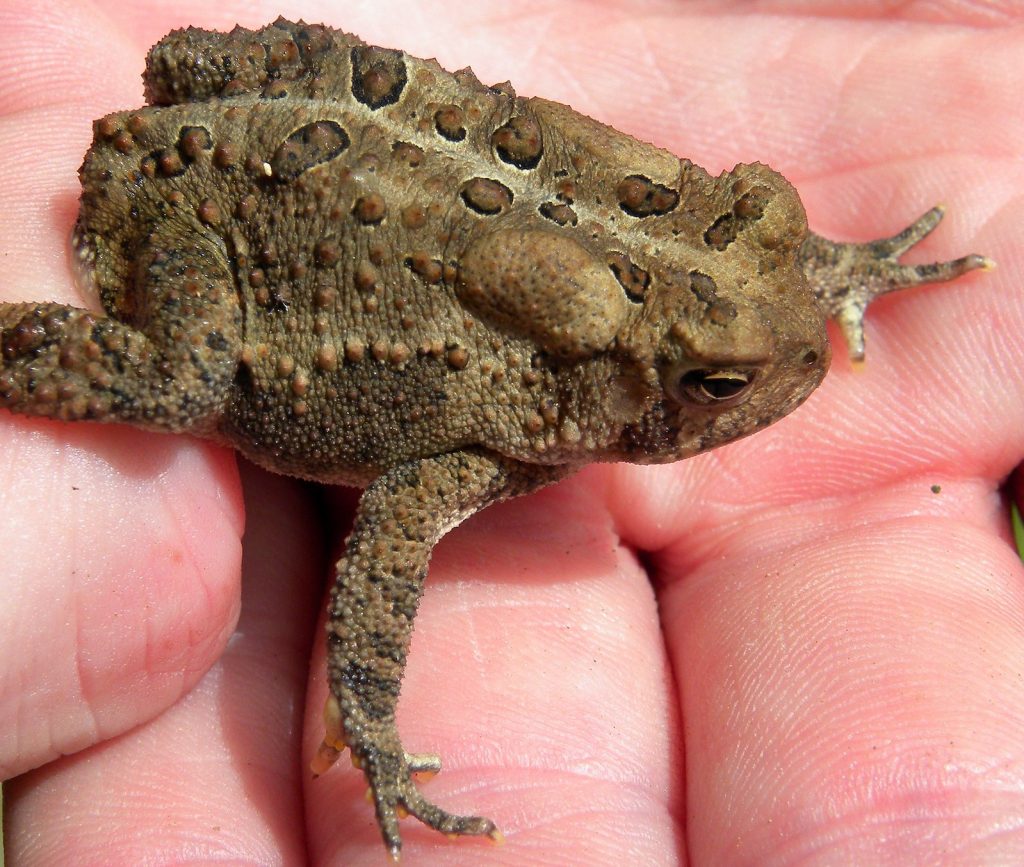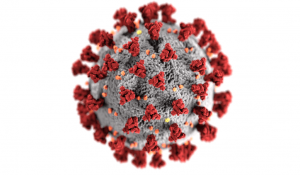I recently volunteered with the Michigan Department of Natural Resources as a citizen scientist. My assignment was to assist with the department’s annual Frog and Toad Survey. The Michigan Frog and Toad Survey began in 1988 with the goal of monitoring the abundance and distribution of anuran populations. Every year the survey collects data from over 800 locations throughout the state. The data is aggregated into one of four state zones (1. southern lower peninsula, 2. northern lower peninsula, 3. eastern upper peninsula, and 4. western upper peninsula). My contributions applied to zone 1, Calhoun County.
The name “anurans” refers to an order of amphibians. Amphibians are a class of vertebrate animals that live in aquatic and terrestrial environments. Amphibians include a variety of salamanders (Caudata) and limbless worm-like creatures of the Gymnophiona order. All members of the amphibian class can breathe and absorb water through their skin.

Photo courtesy of Professor Mark Wilson
The species of interest in the Michigan Frog and Toad Survey are all members of the Anura order of amphibians. Anurans are tailless amphibians that include frogs and toads. They represent the largest and most diverse group of amphibians. Worldwide, there are well over 5000 species of anurans contained in at least 28 family classifications. The terms “frog” and “toad” are not taxonomically well described and are often used interchangeably. Most commonly, anurans with smooth skin and long legs are referred to as frogs and those with rough, warty skins and shorter legs as toads. Scientifically, anurans of the Bufonidae family are considered the only true toads.
Fossil records indicate that the first modern anurans appeared on earth during the early Jurassic period, roughly 200 million years ago. Over the eons, frogs and toads persevered, even through massive extinction events. They survived immense worldwide volcanic eruptions, giant asteroid impacts, oxygen depletion, and changing climatic conditions. Anurans evolved the traits necessary to cope with earth’s natural disasters and have been able to sustain their populations for over 99.99992% of their existence as a species.
Recently though, anurans have encountered new threats for which evolution did not prepare them to survive. For decades, research has shown alarming declines in anuran populations throughout the world (1, 2, 3). In the United States, the U.S. Geological Survey reported that amphibian populations are decreasing by 3.7% per year. The current rate of amphibian loss is about 211 times higher than what normally occurred over their 200 million year history. In fact, today amphibians are dying at rates similar to the mass extinctions that killed the dinosaurs following the K-T Event about 65 million years ago.
It was only during the very last stage of the Holocene Epoch that humans became aware of amphibians dying in such prodigious numbers. We acquired knowledge of the declines because thousands of scientific studies were conducted over multiple decades. It is through research like the Michigan Frog and Toad Survey that enables our recognition of trends that unfold too slowly to be fully understood without careful and long-term data collection.
I joined the anuran study because of previous research that taught me about the value amphibians play in ecosystems. I knew that their unique qualities make them particularly sensitive to environmental degradation, and as such, the health and abundance of amphibian populations are useful indicators of overall environmental quality. Most importantly, I wanted to contribute to the critical work of protecting the earth’s biodiversity.
Extensive research and monitoring of amphibian populations have illuminated the primary causes of their declining numbers. Habitat loss, climate change, environmental contamination, disease, over-harvesting and invasive species are the root causes of most amphibian declines.
The causes of amphibian loss are very similar to the direct drivers responsible for overall reductions in planetary biodiversity. In addition to the direct drivers of biodiversity decline, the unsustainable expansion of the human population and over-dependence on economic growth (1,2,3), have had an indirect but powerful adverse impact on earth’s biodiversity. In all cases the evidence is clear, anthropogenic activities are highly influential on the unprecedented declines in biodiversity we are seeing today.
Species diversity provides an essential utilitarian purpose in maintaining the vital ecosystem services humans need to survive. Diversity plays a direct role in enabling crucial elements needed for human food supplies (1, 2, 3). Biodiversity is linked to cleaner air (1, 2), lower risk of zoonotic disease transmission (1, 2), increased carbon sequestration (1, 2) and therapeutic drug development (1, 2).
Along with the utilitarian values that service human needs, there is also a moral component to protecting the diversity of life on earth. Many people recognize an intrinsic value that species possess. Intrinsic value exists separate from utilitarian value, it recognizes worth beyond just service to humans and our impulse for exploitation. Intrinsic value can not be conferred nor revocated by human whims. Biodiversity represents the totality of life sharing our world, the vast majority of which existed long before human life emerged. All life on earth emerged from the exact same base ingredients and through the exact same biologic and geologic processes (1, 2, 3). Supporting the intrinsic value of other species is based on the acceptance of an ethical code and reverence for the events that breathed life into inorganic matter.
My work with Michigan Frog and Toad Survey gave me the unique opportunity to help expand knowledge about anuran population abundance. The study gave me a broader perspective on diversity within local frog and toad populations. Of the 13 different species native to Michigan, my observations detected only 7 unique species.
The survey also offered an opportunity for me to compare population colonies based on their exposure to urban and protected environments. Half of my observation sites were located within 219 acres of fragmented wetlands, completely surrounded by an urban area. The urban sites were defined as habitat that received direct inputs of anthropogenic disturbance (road runoff, yard runoff, noise and light pollution). The other half were located within a 300 acre protected nature park. The park is protected from motorized vehicle traffic, with no interior structures and limited sources of artificial light. There is a small amount of residential housing running along about 12.5% of the park’s perimeter. The survey data indicated that 59% of the unique species identified (species abundance) were located within the protected area. The protected sites also consistently demonstrated greater species diversity ([wp_colorbox_media url=”https://live.staticflickr.com/65535/50225135743_70515b83dc.jpg” type=”image” hyperlink=”Figure 1″ ] ). The colony comparison did not address causes for the abundance and diversity disparities, however, the findings are consistent with the anthropogenic drivers of biodiversity decline discussed previously.
As mentioned above, modern-day frogs and toads arose roughly 200 million years ago, but their distant Salientia ancestors were alive at least 50 million years earlier. Those early ancestors suddenly disappeared from fossil records, possibly succumbing in large numbers to the “great dying” of the Permian–Triassic extinction event. There have been at least five major mass extinctions throughout earth’s history and there is strong evidence that today, we are in the midst of a sixth mass extinction. Interestingly, the great die-offs occurring now are more unusual and historic than any in the past. Every previous extinction of life on earth came about through natural, uncontrollable events and unfolded without the slightest comprehension of any living creature alive at the time.
I volunteered for the Michigan Frog and Toad Survey not only because it allowed me to contribute to the long-term monitoring (and hopefully protection) of earth’s biodiversity, but also because it offered an opportunity to be part of an extraordinary moment in history. Like countless other research projects conducted over many decades, the frog and toad survey adds to a body of knowledge that is truly unprecedented in the context of geologic history.
After roughly 3.5 billion years of life emerging and repeatedly being extinguished, evolution produced a species that was capable of high-level communication, extraordinary collaboration and possessed profound cognitive abilities. Members of the Homo genus split off into several distinct species, one of which (Homo Sapiens) refined and enhanced their cognitive capabilities to ever more useful degrees. The new cognitive powers enabled Homo Sapiens to employ a never-before-seen ability, the capacity to communicate through discrete symbology. Symbolic thought morphed into creative rearrangements of expression and vocabulary and the capacity to document our experiences. The enhanced mental skills facilitated visualizations of abstract concepts and the talent to trial new scenarios and imagine alternate future outcomes.
It is only in the last 0.00012% of earth’s history that Homo Sapiens began the journey that led to what we know as civilization. From a geologic standpoint, our acquisition of knowledge and “intelligence” was an astonishingly recent event. Out of earth’s 4.5 billion-year history, it took roughly 4.49999984 billion years to produce a species able to obtain deep enough awareness of its surroundings and recognize the wave of mass extinctions going on all around them.
It is an improbable stroke of luck and privilege to be part of the human species at this time and place in history. The story of Homo Sapiens has been marked by the accumulation and dissemination of almost unimaginable knowledge and insight. Our species went from living in caves and foraging for food, to building skyscrapers and developing the technologies to manufacture food. We invented the scientific method, made amazing discoveries about ourselves and our surroundings. We unraveled many mysteries of the universe and landed people and robots on other planets. We developed an extensive understanding of the history of life on earth and an extraordinary ability to accurately predict the future. Most of humanity’s greatest insights came by way of scientific studies and through expanding on the emergent truths that follow reasoned inquiries.
As a species, humans were ordained with the capacity of internal and external awareness. We were granted the potential to acquire knowledge and insight. These extraordinary traits were bestowed exclusively on Homo Sapiens through a series of unlikely events that, to our knowledge, may never have occurred anywhere else in the entire universe.
I joined The Michigan Frog and Toad Survey to help carry on the incredible tradition of investigating our world and expanding human understanding of the environment around us. I joined to help protect biodiversity by utilizing Homo Sapien’s novel cognitive capabilities to prevent the earth’s first self-imposed species extinction. It would be an epic waste of remarkable and highly uncommon opportunity if we do not use the instruments that evolution gave us and the knowledge and insights we have gained to protect and preserve all the unique and interconnected forms of life living on this planet.
